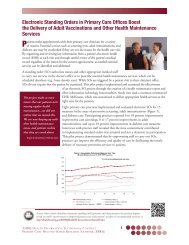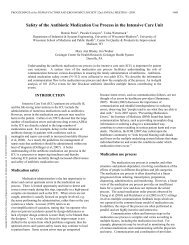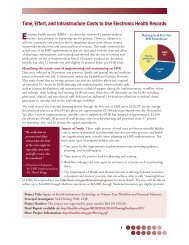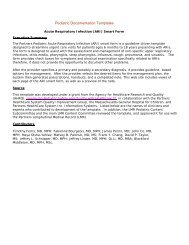Sustainability, Partnership, and Teamwork in Health IT Implementation
Sustainability, Partnership, and Teamwork in Health IT Implementation
Sustainability, Partnership, and Teamwork in Health IT Implementation
You also want an ePaper? Increase the reach of your titles
YUMPU automatically turns print PDFs into web optimized ePapers that Google loves.
Figure 4.5. Cont<strong>in</strong>uation of plann<strong>in</strong>g <strong>and</strong> implementation partnerships after<br />
conclusion of the grant<br />
Did partners cont<strong>in</strong>ue to work together? (n=65)<br />
Yes, 63<br />
(97%)<br />
No, 2<br />
(3%)<br />
With all or just some partners?<br />
All, 32<br />
(51%)<br />
Some, 31<br />
(49%)<br />
Who stopped?<br />
Patient care delivery<br />
organization, 22<br />
(71%)<br />
Research organization, 5<br />
(16%)<br />
Other, 11<br />
(35%)<br />
Source: Survey of THQ<strong>IT</strong> Grantees, conducted <strong>in</strong> summer 2011<br />
Note: <strong>Implementation</strong> grantees (those that received prior plann<strong>in</strong>g grants <strong>and</strong> those that did not) are more likely than<br />
plann<strong>in</strong>g-only grantees to have all partners cont<strong>in</strong>ue to work together after the grant period.<br />
Largely successful at susta<strong>in</strong><strong>in</strong>g activities with some or all of their grant partners for<br />
at least 1.5 years, the THQ<strong>IT</strong> grantees provided <strong>in</strong>sight <strong>in</strong>to strategies that can be<br />
used to build last<strong>in</strong>g relationships between organizations that deliver patient care.<br />
F<strong>in</strong>d<strong>in</strong>g the Unify<strong>in</strong>g Factor<br />
Strong, susta<strong>in</strong>able partnerships identified a shared vision for their projects <strong>and</strong> cont<strong>in</strong>ued to focus<br />
on help<strong>in</strong>g partners achieve their goal for health <strong>IT</strong> implementation. One HIE-focused plann<strong>in</strong>g<br />
grantee reflected, “Hav<strong>in</strong>g a shared vision <strong>and</strong> recogniz<strong>in</strong>g the value of that mission helps strike a<br />
balance between <strong>in</strong>dividual <strong>in</strong>terests <strong>and</strong> achiev<strong>in</strong>g a greater good for everyone.” Grantees suggested<br />
that health <strong>IT</strong> partnerships were most successful when their aim was not simply to implement<br />
technology, but rather to select <strong>and</strong> implement health <strong>IT</strong> to meet a broader common goal. One value<br />
grantee <strong>in</strong>dicated that patient care delivery organizations that compete for the same patients were<br />
able to successfully work together on the project because the partners “really came together to take<br />
care of the Medicaid population. It was the unify<strong>in</strong>g factor.” To identify common goals, grantees<br />
held stakeholder meet<strong>in</strong>gs <strong>and</strong> conducted needs assessments to determ<strong>in</strong>e common areas for quality<br />
improvement. For example, one successful grantee partnership formed when stakeholders at a meet<strong>in</strong>g<br />
39<br />
Chapter 4. Other Cross-Organizational <strong>Partnership</strong>s for <strong>Health</strong> <strong>IT</strong> <strong>Implementation</strong>

















